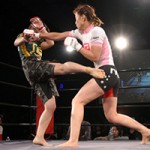
With roots in pro wrestling and true combat disciplines such as kickboxing, the women’s division rose from humble beginnings in 1990s Japan into the successful all-female cards held in the former Smackgirl promotion. SKILL MMA identifies the fights and fighters who have shaped the division.
Shiroobi, with assistance from respected writer and editor Chris Nelson of BloodyElbow and Sherdog, compiled the extensive “Female MMA History” article with the goal of examining the sport’s past and present in a way that very few have done before.
While some newer fans of mixed martial arts have taken steps to learn about the sport’s history on the men’s side, few are likely to be able to name even a handful of MMA’s most influential female fighters. Likewise, even fewer can identify the key moments in time that have shaped the women’s division and brought it to where it is today.
“Female MMA in Japan began when the promotion Ladies Legend Pro Wrestling (LLPW) started its ‘shoot fighting’ Ultimate L-1 Challenge tournament in 1995,” writes Shiroobi. “The first L-1 tourney was ruled by Svetlana Goundarenko, a Russian Olympic judoka who tipped the scales at 150kg (330 lbs).”
While many fans of the women’s division only began to take notice in 2007 with the emergence of Gina Carano, female fighters were competing in the L-1 tournament in Japan just four days after UFC 6 took place in Casper, Wyoming on July 14, 1995. Though “women’s MMA” has only been in the forefront for a few years, talented female fighters have competed in mixed martial arts for nearly as long as the famed Ultimate Fighting Championship has existed.
“After a few shows, LLPW discontinued its experiment, but in that era, female professional wrestling organizations couldn’t ignore MMA,” Shiroobi recalls. “Therefore, Neo Women’s Pro Wrestling started an event named ReMix in 2000.”
“The first ReMix World Cup offered a huge bonus of $100,000 to the tournament winner. That type of money had never before been offered in female MMA, so many foreign fighters came to participate in the events, including current stars like Marloes Coenen and Erin Toughill.”
While the sport – and the women’s division – has come a long way since 2000, a $100,000 fight purse remains out of reach for even the best female fighters competing today. However, the ReMix tournament was the first step towards female fighting gaining acceptance in Japan.
As Shiroobi points out, the ReMix tournament played out in a fashion similar to that of UFC 1, with a 60kg (132-pound) fighter using superior technique to upset the much larger Goundarenko in the event’s semi-final round. The smaller fighter was Megumi Yabushita, who would go on to become one of the most well-known female fighters in Japanese mixed martial arts history.
“From 2001 to 2008, Japanese women’s MMA was ruled by one promotion: Smackgirl. Founded by Neo Women’s Pro Wrestling head Daiki Shinosaki, Smackgirl operated with a limited rule set, prohibiting ground-and-pound and setting a 30-second time limit for ground work. The ground limitation was lifted in 2007, but it stunted the level of skill improvement in the early stages of women’s MMA.”
Much like the disparity in fight purses, scaled-down rules remain an issue in female fights in Japan. As Shiroobi notes, strict limits on striking to the face and time that could be spent on the ground restricted what fighters could do.
“Still, Smackgirl was the only all-female MMA organization in the world to continuously hold events; therefore, almost all of the day’s well-known female fighters passed through the Smackgirl ring.”
It would be close to four years before Pancrase began holding events featuring female fights that used “Athena Rules.” At last, female fighters, including kickboxing converts Hisae Watanabe and “Windy” Tomomi Sunaba, could compete using a rule set that was similar to that of their male counterparts.
Shiroobi goes into great detail in documenting how the women’s division developed with the aid of future stars such as Yuka Tsuji, Ana Michelle Tavares, Megumi Fujii, Watanabe, Sunaba, Satoko Shinashi and Miku Matsumoto, among others.
From title fights to the rise and fall of promotions, to the retirements of some of the sport’s top female fighters, Shiroobi covers all of the major points that have led the women’s division to where it is today; finally respected and accepted as a valued part of mixed martial arts by fans and analysts alike.
SKILL MMA’s in-depth look at the history of the women’s division can be read in its entirety here.
(Photo Credit: GBRing.com)

